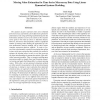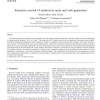17 search results - page 2 / 4 » A dynamical-systems model for Parkinson's disease |
162
click to vote
AINA
2008
IEEE
15 years 6 months ago
2008
IEEE
The analysis of gene expression time series obtained from microarray experiments can be effectively exploited to understand a wide range of biological phenomena from the homeostat...
80
Voted
SAINT
2008
IEEE
15 years 6 months ago
2008
IEEE
The utility of walking parameters such as stride length, cadence and gait velocity for monitoring motor functions of patients suffering from brain injury, Parkinson’s disease an...
ISBI
2009
IEEE
15 years 6 months ago
2009
IEEE
Traditional fMRI analysis has focused on modeling temporal changes in BOLD signals on a voxel-by-voxel basis to infer brain activation. To incorporate spatial information, we have...
100
click to vote
CVPR
2010
IEEE
15 years 7 months ago
2010
IEEE
A central problem in the analysis of motion capture (Mo-
Cap) data is how to decompose motion sequences into primitives.
Ideally, a description in terms of primitives should
fac...
108
click to vote
COGSR
2011
14 years 6 months ago
2011
In verb/noun generation experiments, participants have to produce a word associated with a stimulus (usually a noun) and belonging to a given syntactic category (“verb” or “...


